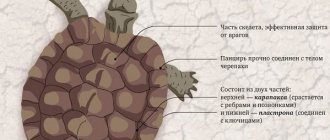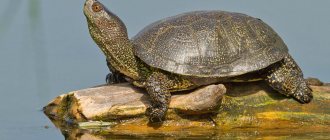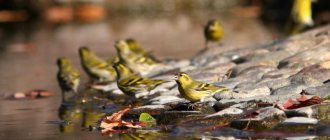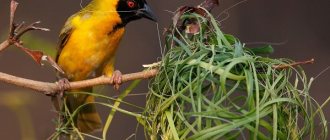Representatives of this breed are freshwater turtles belonging to the genus Swamp turtles. They successfully adapted to life in captivity and quickly gained popularity among reptile lovers. And their natural habitat has expanded noticeably - from European territory to northern Africa. The European marsh turtle is an unpretentious reptile that needs certain conditions and nutrition. Future owners, especially those without experience in keeping such animals, should know their characteristics and needs.
General data and description of the breed representatives
The European marsh turtle looks like other reptiles of this species, but at the same time has some characteristic features. It has an oval, low carapace with a slight convexity, the surface of which is smooth, and the connections with the lower part - the plastron - are movable.
Young animals of this breed have a rounded carapace and a weak central keel on the posterior curve of the carapace. The limbs are equipped with elongated, sharp claws, and between the fingers there are small leathery films that increase the area of contact of the limbs with water.
These turtles boast a very long tail. In an adult, the length of the tail reaches 20-25 cm. Nature gave it for a reason - it is actively used when swimming and is an important part of the steering.
Marsh reptiles, in comparison with their land and sea relatives, have very modest sizes. The length of an adult is 12-38 cm, with a weight of 1.5 kg. But such dimensions allow you to keep these reptiles at home without any problems.
In adult turtles, the carapace is colored dark yellow-greenish, brownish-brown or dark brown, almost black. Small yellow spots, dashes, and dots are scattered on the main background. The lower shield is dark brown or yellowish, with dark spots that do not have clear boundaries.
The head , neck, limbs and tail are also dark, they also have yellow spots, but in small quantities. Eyes with yellow, orange or red irises. A peculiarity of representatives of this species is that the edges jaws are smooth and there is no “beak”.
Natural enemies of land turtles
Photo: Land turtle
Despite reliable protection in the form of a hard shell, turtles have many enemies in nature. Birds of prey (hawks, eagles) hunt them and drop them from a height onto rocks, pecking out their entrails. Crows, magpies, and jackdaws can completely eat barely hatched babies. There have been cases when foxes threw turtles from cliffs onto stones in order to then split their shells and eat them.
In South America, land turtles are hunted very successfully by jaguars. They eat reptiles out of their shells so skillfully that the results of their work can be compared to the activity of a surgeon’s scalpel. At the same time, predators are not content with one turtle, but eat several at once, turning them over on their backs with their paws on flat ground, without grass and stones. Sometimes large rodents, rats, prey on turtles, biting off their tail or limbs. At the same time, the most important enemies of turtles are people who hunt them for eggs, meat, and just for fun.
In addition to predators and humans, the enemies of turtles can be fungi, viruses, and parasites. Often, sick and weak turtles, due to their slowness, become food for ants, which can very quickly gnaw off the soft parts of the body. Some turtles can even engage in cannibalism, eating their relatives if they are unable to escape or resist. As for the giant Galapagos tortoises, given their size and weight, they have no natural enemies.
Interesting fact: Aeschylus, the ancient Greek playwright, died a very ridiculous death. A turtle, picked up by an eagle, fell on his head.
Turtles in their natural environment
The habitat of European marsh turtles is quite wide; they are found in the south, central and eastern regions of Europe, the Caucasus and Asia. Most of the population lives in almost all states that left the Soviet Union.
It is surprising that thanks to research it was possible to find out that representatives of this species were found throughout most of Europe even before the Ice Age. In addition, in some areas, to this day there are residual populations of these reptiles, which are classified as relict.
Habitats
The marsh turtle is distributed in North-West Africa, in Southern and Central Europe, to Smolensk and Ulyanovsk in the north, in Asia - in the east to the Irgiz River and the lower reaches of the Syrdarya, and in the south - to Iran, Iraq and Asia Minor.
It can be found in forest, forest-steppe and steppe areas. The marsh turtle is quite unpretentious in its choice of habitats and settles in bodies of water with weak currents; also common in lakes and floodplain channels among floodplains.
Prefers reservoirs with sloping banks overgrown with reeds, reeds, cattails and other wetland plants.
Lifestyle and behavioral characteristics of marsh turtles
Forest, steppe and forest-steppe areas with natural fresh water bodies are more suitable for these inhabitants. They love to settle in lakes, ponds, swamps, slow-flowing rivers and large water canals.
The most convenient for reptiles are reservoirs of natural origin located on flat terrain - with gently sloping banks and shallow areas, abundantly overgrown with plants and well heated. But you can also find the European marsh turtle in the mountains, where there are small bodies of water.
With the help of experiments, it was possible to prove that representatives of this species are capable of surviving for 2 days at a water temperature of 18°C and the absence of air. This confirms their high viability. During the mating season, adult turtles, ready to breed, can crawl out of the water and set off on a 300-500-meter journey inland.
Swamp turtles are excellent swimmers and divers, and they are also capable of staying under water for a long time, rising to the surface every 10-15 minutes. These animals are semi-aquatic reptiles and are most active during the daytime. They love to crawl onto land or islands and bask in the sun's rays.
Reptiles spend all the time that is not spent resting in search of food - they can eat all day long. And at night they go to sleep at the bottom of the reservoir.
Where does the red-eared turtle live?
Photo: Little red-eared turtle
Habitats are in the Mississippi River and Gulf of Mexico, as well as in the warm climate of the southeastern United States. Their home territories range from southeastern Colorado to Virginia and Florida. In the wild, red-eared turtles inhabit areas with sources of calm, warm water: ponds, lakes, swamps, streams and slow-moving rivers.
They live where they can easily get out of the water, climb onto rocks or tree trunks to warm themselves in the sun. They often sunbathe in a group or even on each other. These turtles in the wild always stay close to water unless they are searching for new habitat or laying eggs.
Due to their popularity as pets, red whales have been released or escaped into the wild in many parts of the world. Wild populations are now found in Australia, Europe, Great Britain, South Africa, the Caribbean, Israel, Bahrain, the Mariana Islands, Guam, and Southeast and Far East Asia.
An invasive species has a negative impact on the ecosystems it occupies because it has certain advantages over native inhabitants, such as a lower age at maturity and higher fertility rates. They transmit diseases and displace other turtle species with which they compete for food and breeding space.
How long do these turtles live?
Representatives of several species of marsh turtles, including European ones, are found in the natural environment. They differ not only in external characteristics, but also in behavior, lifestyle, food preferences, and life cycle duration.
The most common representatives of swamp reptiles are turtles of the European species. But their life expectancy varies noticeably, as it largely depends on the conditions in which the animal lives and territorial characteristics.
All individuals that live in central Europe can live up to half a century, and for reptiles from Ukrainian and Belarusian reservoirs, the life span rarely exceeds 40 years. At home, these pets live no more than 25 years.
Should you bathe your turtle?
Many people often have a question: is it necessary to bathe a turtle? It is simply impossible to maintain full frequency in an aquarium, even with regular care. For this reason, over time, dirt begins to accumulate on the amphibian’s shell, which can only be removed mechanically.
This pet needs to be cared for carefully; it is important that it feels comfortable. The same requirement applies to bathing; in order to perform this procedure yourself, you must follow the following rules:
- Water procedures are required as the amphibian becomes contaminated;
- The animal must be washed in warm water. The shell should be wiped with cotton wool or a soft brush;
- During water procedures, you should not use harsh products that can harm the stratum corneum of the reptile's shell.
You need to keep your animal at home in an aquarium in clean water. The fact is that it defecates directly into it, for this reason it becomes dirty over time. In these cases, even a filter will not be able to completely clean it. Therefore, it is recommended to change it when it gets dirty.
During the shift, do not worry that the turtle will feel discomfort. The reptile can live without water for several days. But if you wish, you can leave a little water in the aquarium.
Conditions for keeping a marsh turtle at home
An owner who decides to get not a dog or a cat, but a marsh turtle, must have certain knowledge about representatives of this species and their needs. It is worth knowing about the following features of keeping reptiles:
- It is important to consider that caring for young, adult and elderly animals is different;
- you should take a serious approach to selecting a tank in which your pet will live;
- it is necessary to pay attention to maintaining water and air parameters, determining a balanced diet and hygiene of the reptile;
- aquarium decor is another important aspect with which you can bring the conditions of an artificial reservoir closer to natural ones; turtles need abundant vegetation, driftwood, an island for rest and other elements.
Kinds
There are 7 main subspecies:
- Emys orbicularis occidentalis - western marsh turtle;
- Emys orbicularis persica - Persian marsh turtle;
- Emys orbicularis galloitalica - Gallo-Italian marsh turtle;
- Emys orbicularis eiselti - Eiselt's marsh turtle;
- Emys orbicularis hellenica - Eastern Mediterranean marsh turtle, Hellenic marsh turtle;
- Emys orbicularis ingauna.
- Emys orbicularis orbicularis is the nominate subspecies.
There are other subspecies of marsh turtles:
- Emys orbicularis luteofusca - golden-black marsh turtle;
- Emys orbicularis colchica - Colchian marsh turtle;
- Emys orbicularis kurae - Kura marsh turtle;
- Emys orbicularis capolongoi - Capolongo marsh turtle;
- Emys orbicularis lanzai - Lanza marsh turtle;
- Emys orbicularis iberica - Iberian marsh turtle;
- Emys orbicularis fritzjuergenobstii - Obst's marsh turtle;
- Emys orbicularis hispanica - Spanish marsh turtle;
- Emys orbicularis orientalis is an eastern marsh turtle.
Subspecies of the marsh turtle differ in size, appearance, as well as location and region of habitat.
How to choose a suitable home for your pet
A couple of adult turtles of this breed require a fairly spacious tank with a volume of more than 300 liters. 1/3 of the total area of the aquaterrarium is allocated to an island of land, crawling out onto which the reptile will rest, basking in the sun. The maximum suitable container parameters are length 150 cm, width 60 cm, height 50 cm.
It is best to keep a marsh turtle in a fenced artificial pond located in the local area. The pond in the garden should be located in an area that receives direct sunlight most of the time and constantly warms the water to the optimal temperature.
An outdoor pond must have shallows and platforms for reptiles to rest and take solar treatments. These aquatic inhabitants use the shoreline for laying eggs, so it must consist of sand. In the south of Russia, based on weather conditions, pets can be placed in a garden pond from March and left there until late autumn. In such conditions, the reptile’s body naturally prepares for the winter.
Turtles overwinter at a temperature of 4°C, so zoologists advise giving your pets an “artificial winter” in a regular household refrigerator. But this applies only to outdoor inhabitants; aquarium reptiles do not need to hibernate, since the ambient temperature does not drop to such levels.
Literature
- Ananyeva N. B., Orlov N. L., Khalikov R. G., Darevsky I. S., Ryabov S. A., Barabanov A. V.
Atlas of reptiles of Northern Eurasia (taxonomic diversity, geographic distribution and conservation status). - St. Petersburg: Zoological Institute of the Russian Academy of Sciences, 2004. - P. 21. - 1000 copies. — ISBN 5-98092-007-2. - Bannikov A. G., Darevsky I. S., Ishchenko V. G., Rustamov A. K., Shcherbak N. N.
Key to amphibians and reptiles of the fauna of the USSR. Textbook manual for students of biology. specialties ped. institutions. - M.: Education, 1977 - P. 73-74. - Gurzhiy A. N.
Aquarium and land turtles. - M.: Delta-M, 1999. P. 74-78. - Zavyalov E.V., Tabachishin V.G., Shlyakhtin G.V.
Modern distribution of reptiles in the north of the Lower Volga region. modern herpetology. 2003. Volume 2. pp. 52-67. - Kurylenko B.G., Verves Yu.G.
Amphibians and lycopes of the fauna of Ukraine: Dovidnik-Viznachnik (Navch. pp.) - K.: Geneza, 1998. - P. 115-119. - Makhlin M. D.
Turtles at your home. - M.: Delta-M, 2000. - P. 35-39. - Orlova V.F., Semenov D.V.
Nature of Russia. Life of animals. Amphibians and reptiles. - M.: "LLC Firm "AST Publishing House", 1999. - P. 131-134. - Pupins M.F., Pupinya A.
Experiences and problems of zooculture of the endangered species in Latvia
Emys orbicularis
L. / Zooculture and biological resources. Materials of the scientific and practical conference. Moscow: T-vo scientific publications KMK. 2005. - Ruchin, A. B., Ryzhov M. K.
Red Book of the Republic of Mordovia: amphibians and reptiles // Natural heritage of Russia: study, monitoring, protection. Mat. intl. scientific conf. Tolyatti 2004. p. 232—233 - Ryzhov M.K.
Finds of a marsh turtle in the Republic of Mordovia // Current problems of herpetology and toxicology. Sat. scientific works Vol. 9. Tolyatti 2006. pp. 159-164. - Life of animals in 7 volumes / Ch. editor V. E. Sokolov.
T. 5. Amphibians and reptiles.
/ A. G. Bannikov, I. S. Darevsky, M. N. Denisova
, etc.;
edited by A. G. Bannikova
- 2nd ed., revised. - M.: Education, 1985. - P. 134-136. - Dinçer Ayaz, Uwe Fritz, Mehmet Kutsay Atatur, Ahmet Mermer, Kerim Cicek, and Murat Aafsar
.
Aspect of Population Structure of the European Pond Turtle ( Emys orbicularis
) in Lake Yayla, Western Anatolia, Turkey. Journal of Herpetology, Vol. 42, No. 3, pp. 518—522, 2008 - G. F. Ficetola, E. Padoa-Schioppa, A. Monti, R. Massa, F. De Bernardi and L. Bottoni
.
The importance of aquatic and terrestrial habitat for the European pond turtle ( Emys orbicularis
): implications for conservation planning and management. Can. J Zool. 82: 1704–1712 (2004). - MAL Zufi, A. Celani, E. Foschi & S. Tripepi
.
Reproductive strategies and body shape in the European pond turtle ( Emys orbicularis
) from contrasting habitats in Italy. Journal of Zoology 271 (2007) 218–224 - M. L. Zuffi, F. Odetti and P. Meozzi
.
Body size and clutch size in the European pond turtle ( Emys orbicularis
) from central Italy. J. Zool., Lond. (1999) 247, 139–143 - P. Lenk, U. Fritz, U. Joger and M. Wink
.
Mitochondrial phylogeography of the European pond turtle, Emys orbicularis
(Linnaeus 1758). Molecular Ecology (1999) 8, 1911–1922 - Slawomir Mitrus
.
Spatial distribution of nests of the European pond turtle, Emys orbicularis
(Reptilia: Testudines: Emydidae), from long-term studies in central Poland. Zoologische Abhandlungen (Dresden) 55, 2006: 95—102 - Uwe Fritz, Tiziano Fattizzo, Daniela Guicking, Sandro Tripepi, Maria Grazia Pennisi, Peter Lenk, Ulrich Joger & Michael Wink
. A new cryptic species of pond turtle from southern Italy, the hottest spot in the range of the genus Emys (Reptilia, Testudines, Emydidae). Zoologica Scripta, Volume 34, Number 4, July 2005, pp. 351—371
How to care for and maintain hygiene of reptiles
First of all, you need to take care of the cleanliness of the water in the tank. Turtles are not the cleanest creatures, they love to eat sloppily in the water and leave a large amount of waste products in it.
The water quickly becomes dirty and cloudy, its flora is pathogenic, putrefactive, and when living in it, reptiles often get sick. Most often, turtles develop eye and skin diseases. To avoid such difficulties, you should equip the aquaterrarium with a powerful and effective filter, which has a large volume and creates a weak current.
To make the process of cleaning the tank as easy as possible and not cause much trouble, you can reduce the amount of decor and reduce the thickness of the soil material under water.
Nutritional Features
In nature, turtles are unpretentious and omnivorous; they often eat small invertebrates. Their diet is also supplemented by insects that live in water and on land. Reptiles consider dragonflies, mosquitoes and other living creatures flying over water bodies to be a real delicacy. Swamp turtles do not disdain small snakes, chicks and even carrion.
When kept in captivity, you should not focus on the omnivorous nature of your pets. You should carefully approach the issue of feeding reptiles; the diet may consist of the following components:
- lean fish
- liver;
- crustaceans and arthropods, including worms and beetles;
- It is best to put live fish into the tank.
Turtles are essentially predators, so 3/4 of their menu should consist of animal food. But for balance, they must also eat plant ingredients, including dry supplements. But it is advisable to give animal food live or frozen. Reptiles happily eat pieces of vegetables, fruits, herbs, and algae.
In addition, you can purchase special complementary foods at pet stores that are suitable for animals of this species. Young reptiles during the period of active growth and pregnant females are fed once a day, and adult individuals are given food once every 2 days.
Reproduction and lifespan
The instinct to procreate comes to them at the age of 5-9 years, which is when turtles mature. The mating season begins immediately after the gradual awakening from hibernation. This does not happen everywhere at the same time, but depends on the climate in the regions. In our temperate latitudes it is April-May.
By that time, the air warms up to +14º C, and the water - to +10º C. The event can take place both in water and on land. If at this moment they are in shallow water, then the backs of the males are visible, which rise above the surface of the reservoir, but the female is not visible, she is completely in the water under them at that time.
The process takes 5-10 minutes. Eggs are usually laid near their native waters. But there are also exceptions. Particularly restless turtles, in order to find a more secluded place for their future offspring, go quite far from home. In warm areas, a female manages to make 3 clutches per season, in cool areas - 1-2.
To lay eggs, the mother digs a hole up to 17 cm deep within 1-2 hours, working with her hind legs. The shape of this depression resembles a jug with a bottom of about 13 cm and a neck of up to 7 cm. She also prepares the place for the hole in advance, carefully clearing a small area of earth with her front paws and head.
The eggs come out gradually, 3-4 eggs approximately every 5 minutes. The number of eggs varies, reaching 19 pieces; they have a hard, white, calcareous shell. They have the shape of an ellipse, measuring from 2.8 * 1.2 to 3.9 * 2.1 cm, and weigh 7-8 g. After all, the female digs a hole and carefully levels the ground above it with her belly, like a bulldozer, masking the laying site.
The incubation period lasts from 60 to 110 days, depending on the climate of the region. Hatched turtles do not immediately rush to the surface. On the contrary, they burrow deeper, overwinter underground and emerge only in the spring. True, there are brave souls who still crawl out and dive into the pond. Then they spend the winter under water.
All babies have a very dark color, closer to black, with only light specks in places. They have a yolk sac on their belly, from which they feed throughout the long winter. Their carapace size is about 2.5 cm, body weight is about 5 g. Turtle nests are constantly destroyed by all predators that are able to reach them.
Swamp turtle eggs are tasty; foxes, otters and crows are not averse to eating them. It is not precisely established how many years these creatures live in nature, but in terrariums their usual age is up to 25 or 30 years. There were cases when emids, with careful supervision, lived up to 90, and even up to 100 years, and in the south of France, in one botanical garden, an age of 120 years was recorded.
Diseases of aquatic reptiles and preventive measures
If you provide the marsh turtle with decent living conditions, you can avoid any problems with its health. She has strong natural immunity and high vitality. Most turtle illnesses are associated with improper housing conditions or poor care. More often than others, the following diseases and pathologies are detected in freshwater reptiles:
- A cold is the result of cooling or keeping your pet in a draft. It manifests itself in the form of irregular, difficult breathing, the appearance of mucous discharge from the nasal passages and oral cavity. The turtle begins to wheeze, refuses to eat, and moves little.
- Rectal prolapse or prolapse of the cloaca (cloacitis) - pathology can occur due to various reasons. Most often it develops against the background of helminthic infestation or prolonged diarrhea. The turtle's cloaca is visible, soil and debris stick to it, and the front limbs may swell.
- Diarrhea - in most cases, is the result of eating low-quality or stale food.
- Nematodosis and cestodosis - tapeworms and roundworms enter the reptile's body from food that has not undergone heat treatment.
- Intestinal obstruction - the main cause is associated with the ingestion of foreign objects - small pebbles, sand, debris. Rarely manifests itself in the form of vomiting, shortness of breath, and neurological disorders.
- Paralysis of various origins.
- Violation or delay in egg laying - a turtle can carry its offspring beyond term due to a narrowing of the birth canal, large egg size, lack of a ready-made nest, and other reasons.
- Infection with ectoparasites - creatures that parasitize the outer surface of the reptile.
In addition, when home furnishings are violated, residents are often injured and their skin is damaged. Often, inexperienced owners of marsh reptiles make a number of mistakes when keeping their pets, which leads to deformation of the armored scutes. More often, this occurs as a result of a deficiency of vitamin components and calcium during the period of active growth and puberty of the individual.
How do European marsh turtles reproduce?
Males have a longer and thicker tail than females, and a slightly concave plastron. Females lay eggs in depressions in the coastal zone, not far from the reservoir. They bury the clutch with ellipsoidal eggs. Reptiles living in an aquaterrarium often give birth to offspring. They reach sexual maturity at 6-8 years of age.
A few days before laying eggs, the expectant mother becomes nervous, anxious, finds it difficult to sit still, and tries to leave the aquarium. You can also catch a turtle digging a hole on an island of land. The babies that have just been born are black in color with a faint yellow pattern. The first food of juveniles is the composition contained in the yolk sac, which is located on the abdomen.
As is the case with other turtles, the sex of representatives of this breed depends on the temperature regime. If during the incubation period the indicator remains at 28°-30°C and above, the newborn turtles turn out to be females. At low temperatures, males appear. With intermediate values, you can get heterosexual offspring.
Availability
The bog turtle can be found commercially or caught in the wild during the warmer months. But, with normal maintenance, owners with zero experience in breeding turtles successfully produce offspring.
All individuals kept in captivity are unpretentious and easy to care for.
However, it is important to note that to keep a marsh turtle, you need to create fairly precise conditions. And just bringing it and putting it in a basin won’t work. If you catch a turtle in the wild and you only need it for fun, then leave it where you found it. Believe me, this way you will make your life easier and will not kill the animal.
How much do turtles of this breed cost and where can they be purchased?
The European marsh turtle has become widespread due to its relative ease of maintenance and unpretentiousness. Another positive quality of these reptiles is their very reasonable price. You can buy such an unusual pet for an average of 1000-2000 rubles, and we are talking about a young individual that can live in an aquarium for a quarter of a century!
When purchasing a turtle, you should give preference to individuals born in captivity. This will reduce the risk of your reptile being sick or infested with parasites. And besides, it adapts much better to new conditions. In any case, before placing a new pet in a general tank, it is recommended to keep it in a quarantine tank.
European marsh turtles are not the rarest representatives of the species, but they not only settled in new territories, but also successfully migrated to aquaterrariums. Today, the number of fans of these reptiles is increasing, because such a pet, although it requires special conditions, does not need walking, does not smell and does not shed. And besides, it can please its owner for decades.
Age determination
The age of swamp turtles, like other species, is determined by the number of growth rings on the carapace. It should be taken into account that in the first or second year of life, 1 ring appears within 3-6 months. After two years, one ring is equivalent to one year of existence.
In nature, growth occurs noticeably faster than with household maintenance. As a result, by the thickness of the last (outer) rings it is easy and simple to determine how many years the turtle spent in captivity.











